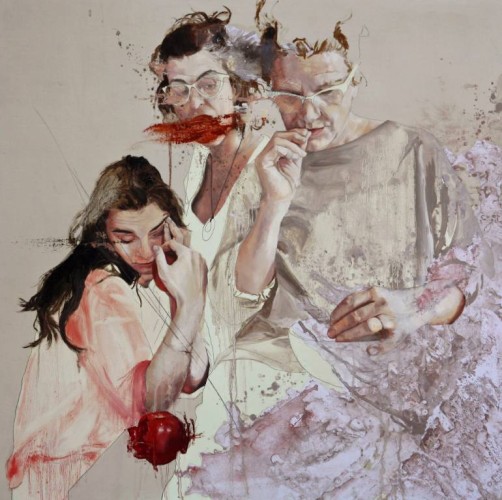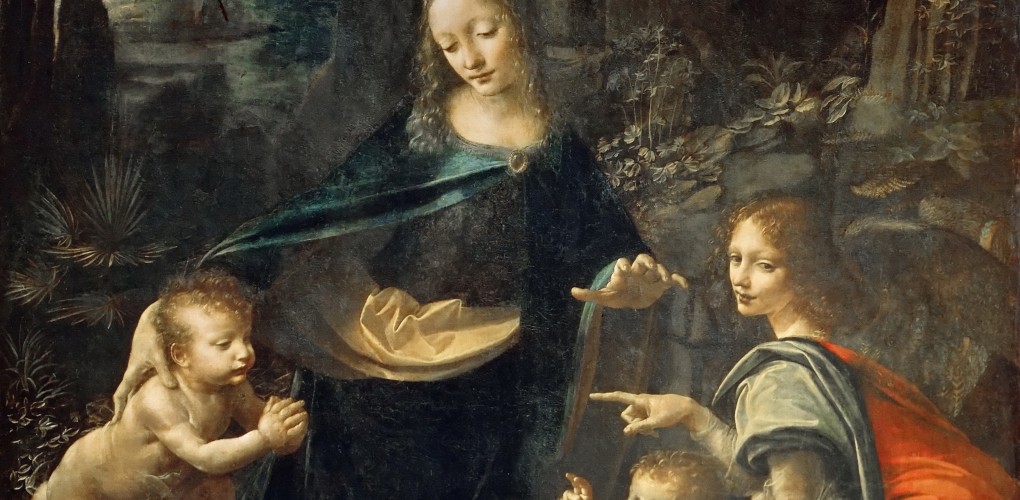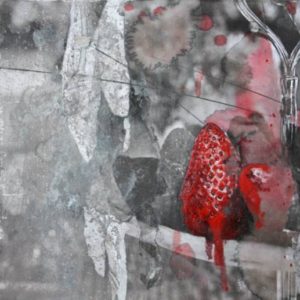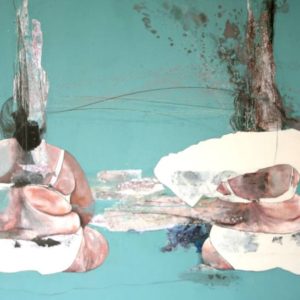Art We Love
The Expansion of One Moment: An Interview with Jessica Rimondi
Discover some of the art that’s catching our eye lately. In this series, we’ll bring you the stories behind some of today’s most fascinating works of art, straight from the mouths of their creators.
Jessica Rimondi is deeply concerned with gesture, establishing shape with motions of her paintbrush and rounding out the concept through form and material. The Berlin-based artist hails from Italy originally, a reality reflected in references to Italian Renaissance painters peppered throughout her work.
Her subjects are painted from real life, culled from photos or memory and combined into a single narrative that encompasses different aspects of an emotional journey. One of her recent paintings, entitled Madre, is no exception, as it presents three figures wrapped into one moment. We asked Jessica to unravel the story behind her painting. Read below to discover more about the work’s symbolism, her materials, and more.

Madre
———-
This piece seems to evoke a generational feeling. Was capturing the passage of time on your mind when you created the work?
This piece is part of a series I started in 2014, which relates common situations to historical works of art. To achieve this, I take and collect photos taken fortuitously in everyday situations that show a strong bond with history of art, concerning compositional elements, structure, subjects, and so on. For this piece I took a photo from a friend of mine (Virginia Chiodi Latini), who did a portrait of her family during an unusual breakfast—as she, her sister, and her mother don’t live together. I think it is really important to know that this photo was not previously prepared or thought for a painting.
When I saw the photo, I felt a connection to Renaissance painting, specifically the theme of “Madonna col Bambino” for the structural body of the picture. I decided to use it for my project and to focus on and capture these elements.
I didn’t before realize this generational feeling you mentioned above, but of course each “Madonna col Bambino” evokes youth and maternity, a kind of feeling that’s been held within this subject for centuries.
What initially struck me are the apples, both in the forefront of the painting and in the younger girl’s hand. It’s a symbol that’s woven through centuries of art, often having a religious or “sinful” meaning but also representing sexuality and love. As you pointed out, Madre also recalls the “Madonna” theme present in Classical and Renaissance painting. Can you tell me a little about the symbolism in this piece?
I astonished myself as I saw the photo that I choose for this painting—it was unexpected but I found a lot of symbolism within the picture. The figures, their attitudes, the apples, the mother are all interpretational elements.
Obviously as yourself noticed, the apple evokes the theme of Christianity, it has a “sinful” meaning, but since the Middle Ages has been used in the theme of “Madonna col Bambino” to mean redemption.
The composition immediately recalls to me the Madonna del Cardellino from Raffaello, but also has some references to Leonardo’s Vergine delle Rocce (Virgin of the Rocks). There is a strong connection with the Renaissance theme of the “Madonna col Bambino.”
The figure in the background plays with the “sinful” apple, and she’s alert. The attitude and the presence of the mother is really important for the balance of the painting and she evokes a strong feeling of protection and authority. It was really interesting to look at all these meanings and symbolism in an ordinary breakfast between a mother and two sisters.
Of course everyone is free to give and find a personal interpretation of things, especially in art, and I think it’s really important to allow the imagination to flow.
For me, it’s necessary to give a new importance to the little things of everyday life, and by comparing them to Classical works of art we can look at them under a different light. We can read/see all the poetry within it. We can say little things of our life are works of art.
The three figures of Madre feel really cohesive despite being comprised of both painting and drawing. What outcome do you seek when mixing different techniques into one painting, and what sort of materials are your go-to?
I usually work on wood, mixing monotype techniques—using traditional oil painting, flat acrylic painting for the background, and drawing. I call this kind of technique “Sensorial process” as it represents for me a way to go into the physiological attitude of my subjects. I try to catch everything, from the way they move, the relationship they have, to how I feel them emotionally.
I think this technique allows me to scrutinize all these aspects and communicate them through a gestural path, trying to go through the boundaries of the formal aspect.












